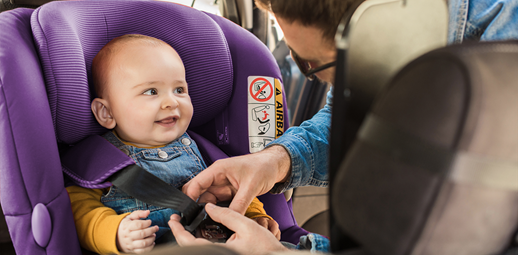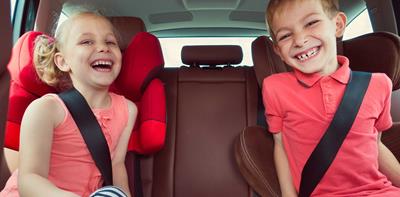
A car seat is one of the most important purchases for parents of young children. And one of the earliest too – most hospitals won't discharge new parents unless they have a child seat in their car.
Choosing the right one, and carefully fitting it according to the manufacturer’s instructions, will give your child the best possible protection in the event of a crash.
According to research, properly restrained infants are on average 12.7 times less likely to present to a trauma centre following a motor vehicle crash.
But more than a fifth (22%) of parents and grandparents surveyed for the RAC in 2020 admitted to not using a child car seat all of the time[1]. Even when seats are used, they may be the wrong type for the child or they might be fitted incorrectly.
It’s essential to be aware of the rules, especially as they frequently change.
New law for backless booster seats
Child car seats come in many different shapes and sizes. For backless booster seats – which raise the child high enough so they can use the adult seatbelt – there was a change in the law in 2017. Since then, only children weighing over 22kg (3st 7lbs), who are also over 125cm (4ft 1ins) tall, are allowed to use them.
Existing booster seats or cushions already in use before the 2017 rule change are still permitted.
What seat does my child need?
For starters, children must use a child seat until they’re 12 years old or 135 centimetres tall, whichever comes first. After that, they must wear a seat belt.
You can choose a seat based on your child’s height or weight. In either case you can only use an EU-approved seat, as shown by a label on the seat showing a capital ‘E’ in a circle.
Height-based seats
Height-based seats, known as ‘i-Size’ seats, were introduced as part of European legislation in 2013.
They are intended to keep children rear-facing for longer – until they are at least 15 months old. According to Brake, in the event of a crash, rear-facing child seats can reduce the likelihood of death and injury in young children and small infants by up to 90%. So even after 15 months, you should be in no rush to swap to a forward-facing seat.
I-Size seats also provide better side impact protection and make car seats easier to fit correctly. They use Isofix fitting points, meaning the seat attaches directly to the frame of your car, rather than relying on a seatbelt. However, not all cars have Isofix connectors. So check before you buy.
Weight-based seats
Eventually only height-based i-Size seats will be allowed in the UK. But this is not yet the case and most child car seats are still grouped according to the weight of the child:
Group 0 seats are for babies up to 10kg: a lie-flat or ‘lateral’ baby carrier, rear-facing baby carrier, or rear-facing baby seat using a harness
Group 0+ seats are for babies who weigh up to 13kg: a rear-facing baby carrier or rear-facing baby seat using a harness
Group 1 seats are for infants who weigh 9-18kg: a rear or forward-facing baby seat using a harness or safety shield
Group 2/3 seats are for children who weigh 15-36kg: a rear or forward-facing child car seat (high-backed booster seat or booster cushion) using a seat belt, harness or safety shield
Choose the right seat
The Royal Society for the Prevention of Accidents (RoSPA) offers tips for choosing the right car seat. These include checking magazines such as Which?, What Car and Mother and Baby, which conduct tests of child car seats and provide useful recommendations. It also advises against buying a second-hand seat, as you don’t know its history and it may have damage you can’t spot.
When buying a seat, RoSPA advises:
- Ask the retailer if the child seat is suitable for your child and car. Try to find one who will help you try the seat in your car before you buy it.
- Ask whether they have staff trained in choosing and fitting child car seats, and try to make sure you are advised by a staff member who has been trained.
- If this is not possible, make sure that you can return the seat, and replace it or get a refund, if it is not suitable.
- Avoid buying a child seat online or by mail order, unless you are sure that it is suitable for your child and will fit your car.
Finding the right car seat and knowing when to swap to the next size can be tricky. Read our car seat myth buster, as well as our guide on booster seats.
Manage your account online
It's easy to manage your insurance online - make a change, review your cover, renewal options and more.
To find out more about how to keep you and your loved ones safe on the roads, go to Solved.
[1] https://www.rac.co.uk/drive/news/motoring-news/over-a-fifth-of-parents-and-grandparents-confess-to-not-using-car-seats/


